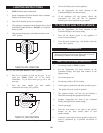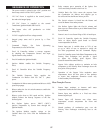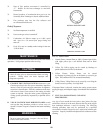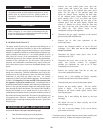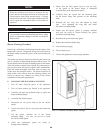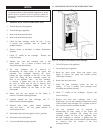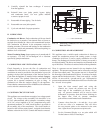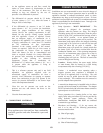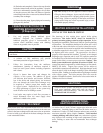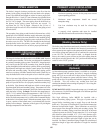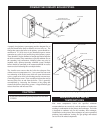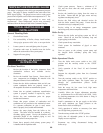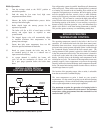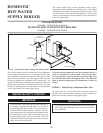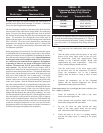
64
(d) Drain the unit completely. Remove the caps from the
two drains located on the rear of the appliance. Open the
relief valve and manually open the bypass valve to allow
air into the system so the water will drain out. Open the
union fitting on the inlet so water can be drained from the
secondary heat exchanger.
(e) Ensure that the pump, bypass piping and connecting
piping are fully drained.
FREEZE PROTECTION FOR A
HEATING BOILER SYSTEM
(If Required)
1. Use only properly diluted in hib it ed glycol
antifreeze designed for hydronic systems.
Inhibited propylene glycol is recommended for
systems where incidental contact with drinking
water or any potable water is possible.
CAUTIONƽ
DO NOT use undiluted or automotive type
antifreeze.
2. A solution of 50% antifreeze will provide
maximum protection of ap prox i mate ly -30°F.
3. Follow the instructions from the antifreeze
manufacturer. Quantity of antifreeze required is
based on total system volume including expansion
tank volume.
4. Glycol is denser than water and changes the
viscosity of the system. The addition of glycol
will decrease heat transfer and increase frictional
loss in the boiler and related piping. An increased
flow rate through the boiler heat exchanger may
be required to achieve proper heat transfer rates
in a glycol system. Reduced flow in a boiler due
to a high percentage of glycol in the system may
result in boiler noise or flashing to steam.
5. Local codes may require a back flow preventer or
actual disconnect from city water supply when
antifreeze is added to the system.
WATER TREATMENT
In hard water areas, water treatment should be used to reduce the
in tro duc tion of minerals to the system. Min er als in the water can
collect in the heat exchanger tubes and cause noise on operation.
Excessive build up of min er als in the heat exchanger can cause
a non-warrantable failure.
WARNINGƽ
DO NOT attempt to fire this appliance without completely
filling the heat exchangers, bypass and all related system
piping. Ensure that all air is properly bled from the system
before firing. Failure to properly fill the boiler and related
piping before firing may result in personal injury or non-
warrantable property damage.
HEATING BOILER INSTALLATIONS
PIPING OF THE BOILER SYSTEM
The drawings in this section show typ i cal boiler piping
installations. This boiler MUST always be installed in a
primary/secondary piping system for proper operation. Before
beginning the installation, consult local codes for specific plumbing
requirements. The installation should provide unions and valves
at the inlet and outlet of the boiler so it can be isolated for ser vice.
An air separation device must be supplied in the installation piping
to eliminate trapped air in the system. Locate a system air vent at
the highest point in the system. The system must also have a
properly sized expansion tank installed. Typically, an air charged
diaphragm-type expansion tank is used. The expansion tank must
be installed close to the boiler and on the suction side of the system
pump (Boiler Inlet) to ensure proper operation. Caution: This
boiler system should not be operated at less than 12 PSIG. Hot
water piping must be supported by suitable hangers or floor stands,
NOT by the boiler. Copper pipe systems will be subject to
considerable expansion and contraction. Rigid pipe hangers could
allow the pipe to slide in the hanger resulting in noise transmitted
into the system. Padding is recommended on rigid hangers installed
with a copper system. The boiler pressure relief valve must be
piped to a suitable floor drain. See the relief valve section in the In -
stal la tion and Service Manual.
CAUTIONƽ
A leak in a boiler “system” will cause the “system” to intake
fresh water constantly, which will cause the tubes to
accumulate a line/scale build up. This will cause a NON-
WARRANTABLE FAILURE.
WATER CONNECTIONS
HEATING BOILERS ONLY
All boilers have 3 inch (76.2mm) copper pipe inlet and outlet
connections. In stalled piping to and from the boiler must be a
minimum of 3 inches (76.2mm) diameter and must not exceed the
maximum spec i fied piping length. Caution: Field installed
reducing bushings must not be used. Any reduction in pipesize
may decrease flow resulting in high water temperatures, boiler
noise, flashing to steam and non-warrantable heat ex chang er
damage.



